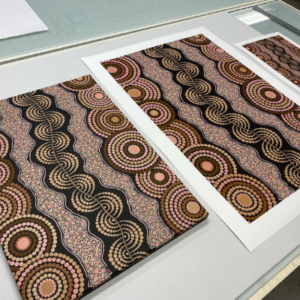Image credit: Sandon Gibbs-O’Neill (artist)
Looking to make prints of your artwork? Typically, there are two options to choose from:
- Open edition prints
- Limited edition prints
As the name suggests, an open edition print means there is no limit to the number of prints that can be produced.
On the other hand, limited edition prints allow for only a fixed number of prints to be produced. Once that number has been reached, an artist can no longer reproduce and sell that particular piece of work.
So, which do you choose?
Well, there are pros and cons to each option and varying opinions in the arts community.
With limited edition prints, some will argue that due to the fixed quantity, these will be more valuable and more collectable. In addition, there is likely a higher chance they will increase in value over time due to rarity.
The downside however, is you are limiting your potential income by capping the number of prints you can produce. And we quite often see successful artists sell out of their limited edition print ranges very quickly.
You could argue that in this age of digital printing, with easier access to art (online) and more affordable price points, the majority of people buying art are not buying for an investment.
So, it begs the question, how important is it to your buyers that they get a limited edition print? Are they buying art as a collectable item or are they buying just because they love it?
Once again it comes down to a personal choice, and also requires you really understand your target audience. Only then can you make the right decision for you and your art business. Whatever you choose, you must be consistent though. Nothing looks worse than an edition print series where the limit has suddenly changed. Buyers will talk and it’s so easy to share negative feedback via social these days, so be careful.
Here are few options to consider when approaching edition prints:
- The most entry level option would be basic prints – unnumbered, generally at smaller sizes and lower price points. We don’t typically see this done much.
- Open edition prints – each print is not numbered but can still be signed and/or embossed by the artist.
- Limited edition prints – numbered by hand and signed by artist either by hand or using a personal embossing tool.
- Special or timed edition prints – these are similar to limited edition prints but might only be offered for a time period.
Choosing edition print sizes
Not going to lie, there is no easy answer to this one. You have to weigh up your income (and potentially capping this) against creating a sense of uniqueness/ rarity with your buyers.
For artists just starting out, we generally recommend taking a more cautious approach. Once you have a read on your market and some indication of demand, then you can look to offer larger editions.
In terms of actual numbers, what does this look like?
We’d recommend somewhere over 25 but less than 75. There is no way to know for sure if this is a good ball park for you, but essentially you have to start somewhere right?
And remember if you do sell out, this isn’t a bad thing. Being able to advertise that you’ve sold out never looks bad. Plus then you know for next time, or produce a similar artwork and up the limit. It’s a little test and learn as you go in the beginning. So having the right mindset will help too.
Printing on demand
This is one of the biggest selling points of art reproduction nowadays. There is no need to print a whole edition up front. Once we have scanned your original artwork, the high resolution file is there ready to make prints as you sell them/ as needed. This minimises the risk on your part.
Inventory – how to track your edition prints?
This is something you need to be on top of from the beginning, especially if you decide to offer limited edition prints. Track, record and track – everything.
Keep an excel spreadsheet or word doc or whatever you’re comfortable with. Record all your sales with the name and print number as well as contact details of the buyers of course.
This way you’re always on top of what you’ve produced and there you are at with your numbers and sales. This can also help with your marketing efforts.
Helpful links:
Top 5 reasons you should reproduce your artwork
Cie-elle fine art reproduction process
